Here in Brazil, I take a 15-minute shower in the morning, just as I would in the United States. I wash the dishes under running water. At home or on campus, I have easy access to as much drinking water as I please.
I arrived in São Paulo in the middle of a horrible drought. Since coming here, I’ve become more aware of how much water I use.
But the reality is, because I live in a wealthier neighborhood, I feel the effects of this crisis much less than the poor do.
Folha de São Paulo reported that this is the worst water crisis in the city’s ?history.
In late July, Brazil’s Public Ministry issued a statement warning Sabesp, the largest water supply and sanitation utility in the area, and the São Paulo state government that the largest reservoir in the state, Cantareira, could run out within 100 days.
The Cantareira system supplies water to about 8.5 million people in São Paulo and surrounding areas.
The state government missed deadlines set by the ministry to begin water rationing, the Los Angeles Times reported. It also reported that the state has been accused of unofficial nighttime water rationing, although Sabesp has denied this.
I have not noticed the water in my apartment being turned off at any time during the day, but other residents in my neighborhood have.
Rodrigo Batista, the owner of a shop down the street from where I live, says his water is turned off nightly.
Water rationing seems to vary depending on the region of the city. Some parts of São Paulo have less access to water than others.
Thaís Felice, a student at the Pontifical Catholic University of São Paulo, also said she has had her water rationed.
“In the northern region (of São Paulo), there is ?rationing during the night. We are without water after midnight,” Felice said.
Pedro Aguerre, a professor of economics and business administration at PUC-SP, said the crisis was caused by the government’s inability to execute proper planning.
The drought is very serious, he said, but the problem lies more with water companies and the state government not investing in water security. If investments in the right places had been scheduled, the crisis could have been avoided, he said.
Aguerre said the management of the crisis has not been very democratic. For the most part, water cutoffs vary by neighborhood. Wealthier areas of the city generally have more access to water and consume more than poorer areas.
It’s hard to imagine turning on a faucet in the U.S. and not having water coming out. Scientific American reported in 2012 that the U.S. was the third-greatest consumer of water.
Brazil consumes less than half the water that we do in the U.S., according to the ?report.
The difference seems to be in administration. In the U.S., it would be more common for state governments to implement heavy fines for households using more water than allowed. Here, the state reduces water pressure without notification.
Poor management within both the federal and state government is a common source of frustration for many Brazilians. Given the lack of real governance, it’s difficult to say when the crisis will reach its breaking point.
“I am very offended and ashamed of those who govern the crisis,” Aguerre said.






